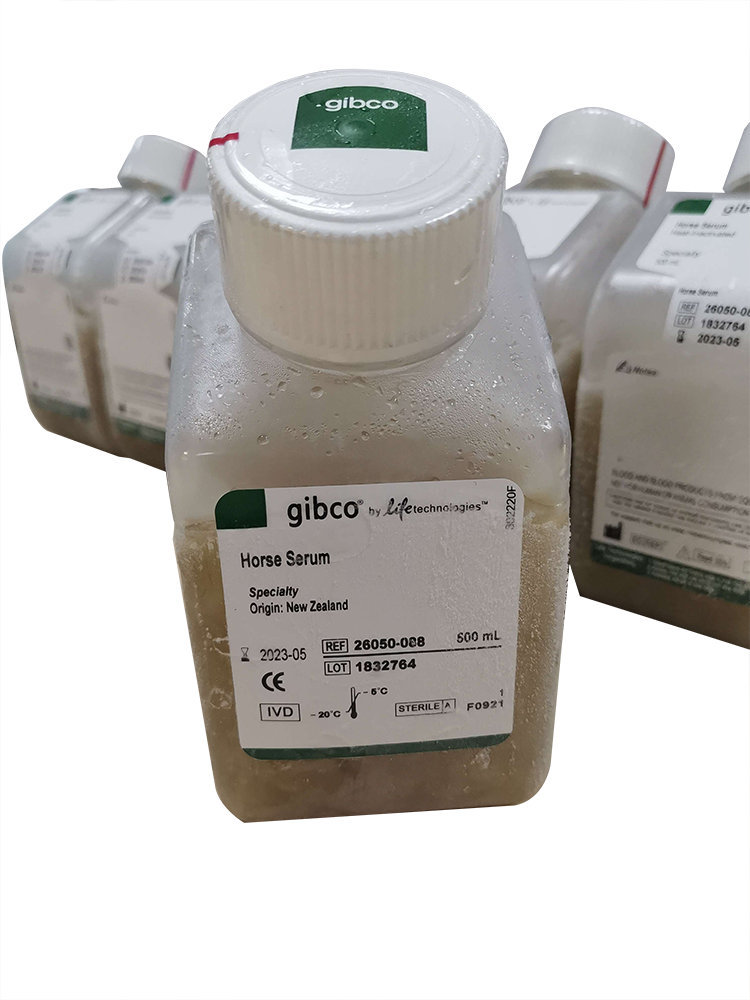Welcome to choose us, Shanghai Hengyuan Biological Technology Co., Ltd.!Free service hotline:400-0899-208
Language:CH Security check
- Location:
- 首页>
- News>
- Industry news>
- How to store and tha...
Industry news
How to store and thaw fetal bovine serum correctly
GIBCO Australian fetal bovine serum is widely used in scientific research market, I believe you all know. But for the use and preservation of fetal bovine serum, not everyone is so clear, today's small series of fetal bovine serum storage, common problems and processing methods for analysis, collection is recommended!

1、 How to store and thaw serum so as not to damage product quality?
The unsealed serum should be stored at - 10 ℃ to - 20 ℃ in general, and can be used within the validity period of the product. If one bottle cannot be used up at a time, it is suggested that the serum should be packed into a sterile centrifuge tube of appropriate size and then put back into refrigeration.
After the serum was taken out from the refrigerator, it was thawed in a refrigerator at 2-8 ℃, and then it was completely dissolved at room temperature or through a water bath. However, it must be noted that the melting process must be regularly shaken evenly. It is recommended to use it as soon as possible after complete dissolution. If stored at 2-8 ℃ for a long time, various (lipoproteins) in serum (such as cold agglutinin, fibrinogen, hyaluronin, etc.) may form precipitates or visible turbidity due to agglutination.
In conclusion: it is recommended to store serum at - 10 to - 20 ℃ and avoid repeated freezing and thawing.
2、 Flocculent precipitates in serum, what are they and how to deal with them?
1. Take out the frozen serum and put it in 4 ℃ refrigerator overnight;
2. After the serum is melted, turn it upside down, mix it gently, and continue at 4 ℃ for 2-3 hours;
3. Gently absorb the upper serum and pack it separately. The remaining 50 ml is about;
4. Centrifuge at low speed for 5 minutes to remove the precipitate.
If flocculent sediment is found after thawing, how to deal with it?
There are many reasons for the appearance of precipitates in fetal bovine serum, but the most common reason is the denaturation of lipoproteins in fetal bovine serum, and blood fibrin (one of the coagulation proteins) also exists in fetal bovine serum after thawing, which is also one of the main reasons for sediment. But these flocculent precipitates do not affect the quality of fetal bovine serum itself. If you want to remove these flocculent precipitates, you can separate fetal bovine serum into sterile centrifuge tubes, centrifuged at 400 g, and then the supernatant can be added into the culture medium and filtered together. We do not recommend that you remove these flocs by filtration, as it may clog your membrane.
When thawing fetal bovine serum, please follow the suggested step-by-step thawing method (- 20 ℃ to 4 ℃ to room temperature). If the temperature of thawing fetal bovine serum is too large (such as - 20 ℃ to 37 ℃), the experiment shows that it is very easy to produce precipitates. When thawing fetal bovine serum, please shake it evenly at any time to make the temperature and composition uniform and reduce the occurrence of precipitation. Do not keep fetal bovine serum at 37 ℃ for too long. If placed at 37 ℃ for too long, fetal bovine serum will become turbid, and many unstable components in fetal bovine serum will be damaged, which will affect the quality of fetal bovine serum. Heat inactivation of fetal bovine serum (FBS) is very easy to cause the increase of precipitates. If it is not necessary, this step is unnecessary. If it is necessary to inactivate fetal bovine serum, please follow the principle of 56 ℃ for 30 minutes and shake it evenly at any time.

3、 How to avoid precipitation in serum?
1. When thawing, please shake it evenly at any time to make the temperature and composition uniform;2. When the sub package is frozen, shake it regularly and evenly (be careful not to cause bubbles);
3. Do not thaw directly from - 20 ℃ to 37 ℃ in a water bath. If the temperature difference is large, it is easy to cause protein condensation and precipitation;
4. Do not put the serum at 37 ℃ for a long time, otherwise it may make it turbid, and some unstable components will also be affected, which will eventually reduce the quality of serum;
5. The heat inactivation of serum is very easy to cause the increase of sediment. If it is not necessary, this step is unnecessary;
6. If heat inactivation of serum is necessary, please follow the principle of 56 ℃ for 30 minutes, and keep shaking evenly. Too high temperature, too long time or uneven shaking will cause the increase of sediment.
4、 What is the "black glue bug" in serum?
During cell culture, sometimes we can see the small black spots moving under a 400 times microscope. The small black spots sometimes appear as dots, sometimes as small flakes. The movement form is vibration in situ, similar to Brownian motion. This kind of small black spots are neither bacteria, mold, nor mycoplasma. At present, people in the industry call them "black glue insects".
Whether the black gum insect is a kind of biological or non biological is controversial. Generally, the black glue insect exists in the serum, and the serum is usually filtered by 0.1 μ M filter membrane, so there are no bacteria, mold and Mycoplasma in the serum. If we say that the black glue insect is not a living thing, it will increase continuously. When it reaches a certain number, it will compete with the cells to grow and compete with the cells for the nutrition in the culture medium, so that the cells will die due to insufficient nutrition.
More interesting content can be paid attention to "Hengyuan" official account of WeChat or visit Hengyuan BIE shopping mall. http://www.hyswsh.com )

Related News
- Explanation of references cited in the earthworm 8-hydroxydeoxyguanosine (8-OHdG) ELISA kit
- Constant biology | those things that fit the ELISA curve
- How to collect high quality animal serum?
- Changyuan Biology | Inflammatory factor-interleukin-6
- Zebrafish Advanced glycation End Products (AGEs)ELISA Manual
- Do you know the method of cell lysis
News
The Latest News
- Notice of New Year's Day Holiday for Hengyuan Biology in 2024
- Explanation of references cited in the earthworm 8-hydroxydeoxyguanosine (8-OHdG) ELISA kit
- Warm winter special, right here in Tsunetō!
- Constant biology | those things that fit the ELISA curve
- Hengyuan Biology: This Month Gao Min Elisa kit hot recommendations
- Hengyuan Biology | November new Elisa kit SCI literature, IF total score of 125.8!
- How to collect high quality animal serum?
- Changyuan Biology | Inflammatory factor-interleukin-6
- Hengyuan Biology: Plant Elisa kit new product index recommendation

